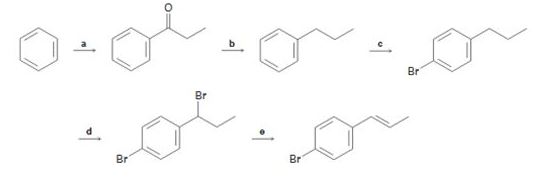
OWLv2 with Student Solutions Manual eBook, 4 terms (24 months) Printed Access Card for McMurry's Organic Chemistry, 9th
9th Edition
ISBN: 9781305671874
Author: John E. McMurry
Publisher: Cengage Learning
expand_more
expand_more
format_list_bulleted
Concept explainers
Textbook Question
Chapter 16.SE, Problem 74AP
Identify the reagents represented by the letters a-e in the following scheme:

Expert Solution & Answer
Trending nowThis is a popular solution!

Students have asked these similar questions
a. Write the product For each of the
Following reactions
H
6-836-6
레
+H₂ N
A
H
A-C-C=C-C-CH + 2 Na +2 NH3 -
H H
b. Write the reaction Mechanism For.
reaction
each
help draw the molecule
How to draw this claisen condensation reaction mechanisms/
Chapter 16 Solutions
OWLv2 with Student Solutions Manual eBook, 4 terms (24 months) Printed Access Card for McMurry's Organic Chemistry, 9th
Ch. 16.1 - Prob. 1PCh. 16.2 - Propose a mechanism for the electrophilic...Ch. 16.2 - How many products might be formed on chlorination...Ch. 16.2 - When benzene is treated with D2SŪ4. deuterium...Ch. 16.3 - Prob. 5PCh. 16.3 - What is the major monosubstitution product from...Ch. 16.3 - Identify the carboxylic acid chloride that might...Ch. 16.4 - Rank the compounds in each of the following groups...Ch. 16.4 - Predict the major products of the following...Ch. 16.4 - Prob. 10P
Ch. 16.4 - Prob. 11PCh. 16.4 - Acetanilide is less reactive than aniline toward...Ch. 16.4 - Prob. 13PCh. 16.5 - At what position would you expect electrophilic...Ch. 16.5 - Show the major product(s) from reaction of the...Ch. 16.6 - The herbicide oxyfluorfen can be prepared by...Ch. 16.7 - Treatment of p-bromotoluene with NaOH at 300°C...Ch. 16.8 - Prob. 18PCh. 16.8 - Prob. 19PCh. 16.8 - Prob. 20PCh. 16.9 - Prob. 21PCh. 16.10 - Prob. 22PCh. 16.10 - Prob. 23PCh. 16.SE - Prob. 24VCCh. 16.SE - The following molecular model of a...Ch. 16.SE - Prob. 26VCCh. 16.SE - Prob. 27VCCh. 16.SE - Aromatic iodination can be carried out with a...Ch. 16.SE - Prob. 29MPCh. 16.SE - The carbocation electrophile in a Friede1-Crafts...Ch. 16.SE - Prob. 31MPCh. 16.SE - The nitroso group, —N=O, is one of the few...Ch. 16.SE - Triphenylmethane can be prepared by reaction of...Ch. 16.SE - Using resonance structures of the intermediates,...Ch. 16.SE - Benzene and alkyl -substituted benzenes can be...Ch. 16.SE - Prob. 36MPCh. 16.SE - Hexachlorophene, a substance used in the...Ch. 16.SE - Benzenediazonium carboxylate decomposes when...Ch. 16.SE - 4-Chloropyridine undergoes reaction with...Ch. 16.SE - Propose a mechanism to account for the following...Ch. 16.SE - In the Gatterman-Kochreaction, a formyl group...Ch. 16.SE - Treatment of p-tert-butylphenol with a strong acid...Ch. 16.SE - Benzyl bromide is converted into benzaldehyde by...Ch. 16.SE - Prob. 44MPCh. 16.SE - Prob. 45MPCh. 16.SE - Prob. 46APCh. 16.SE - Prob. 47APCh. 16.SE - Prob. 48APCh. 16.SE - Predict the major monoalkylation products you...Ch. 16.SE - Name and draw the major product(s) of...Ch. 16.SE - Prob. 51APCh. 16.SE - Prob. 52APCh. 16.SE - What product(s) would you expect to obtain from...Ch. 16.SE - Prob. 54APCh. 16.SE - How would you synthesize the following substances...Ch. 16.SE - Prob. 56APCh. 16.SE - Prob. 57APCh. 16.SE - Prob. 58APCh. 16.SE - Prob. 59APCh. 16.SE - Prob. 60APCh. 16.SE - Prob. 61APCh. 16.SE - Prob. 62APCh. 16.SE - Prob. 63APCh. 16.SE - How would you synthesize the following substances...Ch. 16.SE - Prob. 65APCh. 16.SE - Prob. 66APCh. 16.SE - Draw resonance structures of the intermediate...Ch. 16.SE - Prob. 68APCh. 16.SE - p-Bromotoluene reacts with potassium amide to give...Ch. 16.SE - Prob. 70APCh. 16.SE - Prob. 71APCh. 16.SE - Prob. 72APCh. 16.SE - Use your knowledge of directing effects, along...Ch. 16.SE - Identify the reagents represented by the letters...Ch. 16.SE - Phenols (ArOH) are relatively acidic, and the...Ch. 16.SE - Prob. 76APCh. 16.SE - Prob. 77APCh. 16.SE - Melamine, used as a fire retardant and a component...
Knowledge Booster
Learn more about
Need a deep-dive on the concept behind this application? Look no further. Learn more about this topic, chemistry and related others by exploring similar questions and additional content below.Similar questions
- Write all of Me Possible Products For each Of the Following reactions. In each case identity all pains of enantiomers, all digsterzoners and all Meso compounds 9. 11-60 11-0-11 V-G Η Η H ~ C-11 +HB+ - 1 H b. पन्ना 171-0-11 H-C-H Н C-C=c-call +HBr Perendez ==arrow_forwardHow can i draw the mechanisms for this molecule?arrow_forwarda. Discuss and explain he difference IN Stability between the Chai and Boat Гольцу от судомехане b. For the Following Molecule draw both possible Clain conformations and explain which one is more stable and for what Reason. H. CH₂ CH₂ H "Harrow_forward
- Please provide the mechanism for this reacitonarrow_forwardQuestion 5: Name the following compound in two ways using side chain and using prefix amine (Common name and IUPAC name both) CH3NH2 CH3CH2NHCH3 CH₂CH₂N(CH3)2 Draw the structure of diethyl methyl amine Question 6. Write the balanced combustion reaction for: a. Hexane b. Propyne c. 2-pentene Question 7: Write the following electrophilic substitution reactions of benzene: Hint: Use notes if you get confused a. Halogenation reaction: b. Nitration reaction : c. Sulphonation reaction: d. Alkylation reaction: e. Aceylation reaction:arrow_forwardQuestion 4. Name the following structures ○ CH3-C-N-H H CH3CH2-C-N-H H CH3CH2-C-N-CH3 Harrow_forward
arrow_back_ios
SEE MORE QUESTIONS
arrow_forward_ios
Recommended textbooks for you

 Organic ChemistryChemistryISBN:9781305580350Author:William H. Brown, Brent L. Iverson, Eric Anslyn, Christopher S. FootePublisher:Cengage Learning
Organic ChemistryChemistryISBN:9781305580350Author:William H. Brown, Brent L. Iverson, Eric Anslyn, Christopher S. FootePublisher:Cengage Learning


Organic Chemistry
Chemistry
ISBN:9781305580350
Author:William H. Brown, Brent L. Iverson, Eric Anslyn, Christopher S. Foote
Publisher:Cengage Learning
Characteristic Reactions of Benzene and Phenols; Author: Linda Hanson;https://www.youtube.com/watch?v=tjEqEjDd87E;License: Standard YouTube License, CC-BY
An Overview of Aldehydes and Ketones: Crash Course Organic Chemistry #27; Author: Crash Course;https://www.youtube.com/watch?v=-fBPX-4kFlw;License: Standard Youtube License